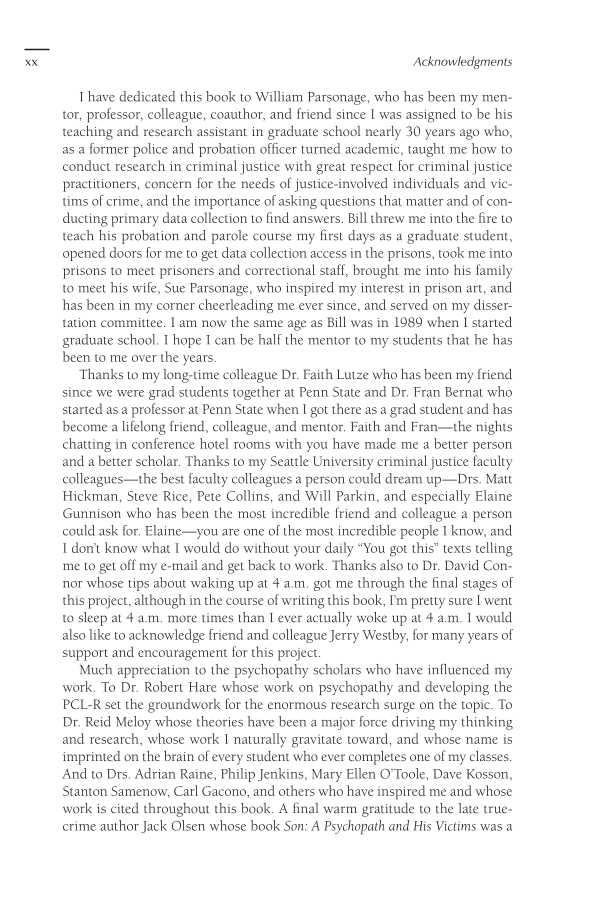xx Acknowledgments I have dedicated this book to William Parsonage, who has been my men- tor, professor, colleague, coauthor, and friend since I was assigned to be his teaching and research assistant in graduate school nearly 30 years ago who, as a former police and probation officer turned academic, taught me how to conduct research in criminal justice with great respect for criminal justice practitioners, concern for the needs of justice-involved individuals and vic- tims of crime, and the importance of asking questions that matter and of con- ducting primary data collection to find answers. Bill threw me into the fire to teach his probation and parole course my first days as a graduate student, opened doors for me to get data collection access in the prisons, took me into prisons to meet prisoners and correctional staff, brought me into his family to meet his wife, Sue Parsonage, who inspired my interest in prison art, and has been in my corner cheerleading me ever since, and served on my disser- tation committee. I am now the same age as Bill was in 1989 when I started graduate school. I hope I can be half the mentor to my students that he has been to me over the years. Thanks to my long-time colleague Dr. Faith Lutze who has been my friend since we were grad students together at Penn State and Dr. Fran Bernat who started as a professor at Penn State when I got there as a grad student and has become a lifelong friend, colleague, and mentor. Faith and Fran—the nights chatting in conference hotel rooms with you have made me a better person and a better scholar. Thanks to my Seattle University criminal justice faculty colleagues—the best faculty colleagues a person could dream up—Drs. Matt Hickman, Steve Rice, Pete Collins, and Will Parkin, and especially Elaine Gunnison who has been the most incredible friend and colleague a person could ask for. Elaine—you are one of the most incredible people I know, and I don’t know what I would do without your daily “You got this” texts telling me to get off my e-mail and get back to work. Thanks also to Dr. David Con- nor whose tips about waking up at 4 a.m. got me through the final stages of this project, although in the course of writing this book, I’m pretty sure I went to sleep at 4 a.m. more times than I ever actually woke up at 4 a.m. I would also like to acknowledge friend and colleague Jerry Westby, for many years of support and encouragement for this project. Much appreciation to the psychopathy scholars who have influenced my work. To Dr. Robert Hare whose work on psychopathy and developing the PCL-R set the groundwork for the enormous research surge on the topic. To Dr. Reid Meloy whose theories have been a major force driving my thinking and research, whose work I naturally gravitate toward, and whose name is imprinted on the brain of every student who ever completes one of my classes. And to Drs. Adrian Raine, Philip Jenkins, Mary Ellen O’Toole, Dave Kosson, Stanton Samenow, Carl Gacono, and others who have inspired me and whose work is cited throughout this book. A final warm gratitude to the late true- crime author Jack Olsen whose book Son: A Psychopath and His Victims was a
Document Details My Account Print multiple pages
Print
You have printed 0 times in the last 24 hours.
Your print count will reset on at .
You may print 0 more time(s) before then.
You may print a maximum of 0 pages at a time.









































































































































































































































































































































































































